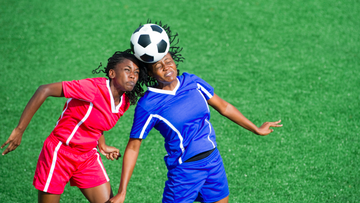Shin splints ain’t nothing to play with, especially if you’re a female soccer player! A common affliction among runners, these painful injuries also strike soccer players, especially women who play at a high level. This post will examine what shin splints are, how they happen in soccer, and how to prevent them.
What in the world are shin splints?
Known medically as medial tibial stress syndrome, shin splints refer to pain felt along one’s shin bone. The pain most often affects athletes who have recently increased their training intensity or volume. Essentially, these shin splints are the result of overworked muscles and repetitive stress on bone tissue, which leads to pain.
Symptoms of shin splints
- Tenderness of the shins
- Numbness in the feet
- Soreness or pain along the inner side of the shinbone
- Mild swelling of the lower leg
- Pain that improves with rest
- Pain that worsens during or after training
Untreated shin splints can worsen and turn into stress fractures, which cause more symptoms and requires more treatment.
How shin splints occur in soccer
Don’t underestimate the beating your legs take when playing soccer. All the contact your lower legs make with the ball, not to mention all the other maneuvers you perform can lead to shin splints. With that said, you can get shin splints from the following:
- Running and sprinting
- Kicking the ball
- Dribbling the ball
- Handling the ball
- Making contact with other players
Doing any of the following at a high volume and frequency can lead to shin splints. And that might sound like a nightmare, considering those are the fundamentals of soccer. But that’s where risk factors come into play.
Why women are at an elevated risk of shin splints in soccer
Biology is unfair but it gives us the answer as to why women get shin splints more often than men. Men and women differ anatomically, especially when it comes to the Q-angle, a factor we’ve discussed at length in previous posts.
Essentially, the Q-angle is the angle formed between the quad muscles and the patella tendon, which looks like a triangle in diagrams. Women have wider Q-angles than men due to having wider hips. The issue here is that wider angles alter running biomechanics, especially if leg bones are partially rotated or misaligned.
Constant running and kicking put pressure on already-stressed bones. Also, women tend to have thinner bones and by extension, lower bone density than their male counterparts. This further increases the risk of suffering shin splint injuries.
How to prevent shin splints
The good news is that shin splints aren’t a doom and gloom, inevitable injury for women in soccer. Preventing shin splints boils down to two things: 1) Balancing training volume, and 2) Wearing protective gear. Regarding the first one, balancing training volume means warming up to a more intense regimen.
For example, if you’re practicing penalty kicks or dribbling, don’t jump into a routine that is twice as hard as your old routine in just a few days. That can be tricky depending on your coach, your level of play, and the league you’re in. However, if possible, give yourself more time, ideally three or four weeks. You’ll thank yourself.
The second way to prevent shin splints is a more passive one, yet vital nonetheless—wearing shin guards and soccer leg guards. Remember, you’re kicking a ball constantly, and getting kicked in the shins by opponents occasionally. Over time, the hits add up, stressing the bone structure and musculature in your legs. A shin guard secured under a leg guard acts as a protective barrier against the impact of kicks and hits on the shin.
Other ways to prevent shin splints
- Incorporate soccer conditioning drills to strengthen your shins and surrounding leg muscles.
- Eat a nutritious diet rich in protein, vitamin D, and calcium, as these nutrients increase muscle strength and bone density.
- Wear supportive orthotics since poor foot arches can increase the risk of shin splints as well.
Keep shin splints sidelined
Shin splints are generally easy to treat, with standard rest, ice, compression, and elevation (RICE) protocols. But they’re troublesome enough to keep you on the bench. That’s why prevention is the name of the game.
When it comes to a new training schedule, don’t rush the process and build up the intensity. And don’t forget to wear your shin guards and leg sleeves. Assuming you protect your shins, you’ll most likely never get held back by this nagging injury.
Looking for shin protection you can rely on? Check out our Storelli BodyShield Leg Guards for no-nonsense, irritation-free coverage!

